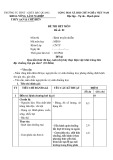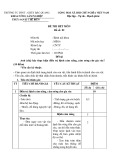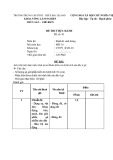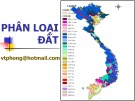
T
ẠP CHÍ KHOA HỌC
TRƯ
ỜNG ĐẠI HỌC SƯ PHẠM TP HỒ CHÍ MINH
Tập 21, Số 6 (2024): 998-1006
HO CHI MINH CITY UNIVERSITY OF EDUCATION
JOURNAL OF SCIENCE
Vol. 21, No. 6 (2024): 998-1006
ISSN:
2734-9918
Websit
e: https://journal.hcmue.edu.vn https://doi.org/10.54607/hcmue.js.21.6.4304(2024)
998
Research Article1
SNAIL SPECIES COMPOSITION AND TREMATODE LARVAE
IN SNAILS FROM SMALL CANALS IN THREE INLAND
DISTRICTS IN HO CHI MINH CITY, VIETNAM
Pham Cu Thien1*, Nguyen Thi Lan2
1Ho Chi Minh City University of Education, Vietnam
2Nguyen Huu Canh High School, Binh Tan District, Ho Chi Minh City, Vietnam
*Corresponding author: Pham Cu Thien – Email: thienpc@hcmue.edu.vn
Received: June 01, 2024; Revised: June 06, 2024; Accepted: June 24, 2024
ABSTRACT
A study on the snail species composition and their cercariae was conducted in eight sixth-level
canals across three inland districts in Ho Chi Minh City, namely Cu Chi, Hoc Mon, and Binh Chanh.
The time of the study was in January 2022 (the dry season) and July 2022 (the wet season). A total
of 584 snail samples, representing 12 species from 12 genera and 7 families, were collected and
identified using morphological methods, with Melanoides tuberculata being the most dominant
species. The total number of snail species observed during the rainy season (12 species) was higher
than during the dry season (11 species). Four snail species were found to be infected with Xiphidio
cercariae: Bithynia siamensis, Filopaludina sumatrensis, Sinotaia lithophaga, and Melanoides
tuberculata while Indoplanorbis exustus was infected with Echinostome cercariae. The prevalence
of trematode infection in snails was higher in the wet season compared to the dry season (P<0.05).
The other seven snail species were free of cercariae. The findings provide valuable information about
the diversity of snails in the canals of the inland districts of Ho Chi Minh City. Further research on
snails and cercariae in canals that supply water directly to fishponds and rice fields is recommended
to support sustainable agricultural development.
Keywords: canal; cercariae; inland; snail; trematode; Vietnam
1. Introduction
Snail is the first intermediate host in the life cycle of trematodes (Thai, 2022).
Freshwater snails also play an important role in the ecological system of water bodies (Do,
2015). Lots of studies on the diversity of snail species have been done in different areas.
Dang et al. (1980) found 47 freshwater snail species in the North of Vietnam. Bui et al.
(2010) collected 16 snail species in two communes of the Nghia Phu district of Nam Dinh
province, and species of the Bithyniidae, Stenothyridae, and Planorbidae dominated in small
Cite this article as: Pham Cu Thien, & Nguyen Thi Lan (2024). Snail species composition and trematode larvae
in snails from small canals in three inland districts in Ho Chi Minh City, Vietnam. Ho Chi Minh City University
of Education Journal of Science, 21(6), 998-1006.

HCMUE Journal of Science
Vol. 21, No. 6 (2024): 998-1006
999
canals. Nguyen et al. (2014) researched two communes of Tuy An district, Phu Yen
province, and got 11 snail species. Ha et al. (2014) discovered 14 freshwater snails from rice
fields, fishponds, and canals in Vinh Long and Dong Thap provinces. In Can Gio, Ho Chi
Minh City, Nguyen and Pham (2022) collected 16 snail species in 4 sixth-level canals.
Cercariae infections have been observed in numerous snail species. In Nam Dinh
province, northern Vietnam, pleurolophocercous, echinostome, and xiphidio cercariae were
identified in snails, with Bithynia fuschiana and Melanoides tuberculata exhibiting the most
diverse trematode fauna (Bui et al., 2010). In Tuy An district, Phu Yen province,
pleurolophocercariae, xiphidio cercariae, echinostome, monostome, and gymnocephalus
cercariae were recovered from 11 snail species (Nguyen et al., 2014). Additionally, xiphidio
cercariae, echinostome cercariae, and pleurolophocercous cercariae were detected in
Melanoides tuberculata and Bithynia species in Can Gio, Ho Chi Minh City (Nguyen &
Pham, 2022).
In the three inland districts of Ho Chi Minh City, there were several studies on snails
and their cercariae in rice fields. Melanoides tuberculata, Filopaludina martensi martensi,
and Cipangopaludina japonica in Cu Chi rice field were infected with xiphidio cercariae,
furcocercous cercariae, and pleurolophocercous cercariae (Pham & Duong, 2023). Xiphidio
cercariae, echinostome cercariae, and cystophorous cercariae were identified in Bithynia
siamensis and Lymnaea viridis collected from rice fields in Binh Chanh (Pham et al., 2023).
Lymnaea viridis and Bithynia siamensis were infected with Xiphidio cercaria and
Echinostome cercariae (Pham, 2024). To learn more about the snail composition in this
natural area and its affection for fish culture, research on snails and their cercariae in the
small canals in these three inland districts of Ho Chi Minh City was implemented.
2. Materials and methods
Study areas
Madsen et al. (2015) found that snails were mainly distributed in canals, fishponds,
and rice fields with the highest trematode prevalence in small canals; therefore, all the sixth-
level canals in all three inland districts of Ho Chi Minh City were chosen for the research.
The sixth-level canal was the lowest range in the waterway system which connected rivers
directly to canals supplying water to rice fields, fish farms, and residential areas. According to
Decision No 40/2019/QĐ-UBND by Ho Chi Minh City People’s Committee dated 20
December 2019, there were eight sixth-level canals in all these three districts: Cu Chi, Hoc
Mon, and Binh Chanh (Table 1).

HCMUE Journal of Science
Pham Cu Thien et al.
1000
Table 1. Total canals in three inland districts of Ho Chi Minh City, Vietnam
No Name of canals District
Sample in the dry
season (January
2022)
Sample in the
wet season
(July 2022)
1
Lang The – Ben Muong canal
Cu Chi
4
4
2
Dia Phan canal
Cu Chi
4
4
3
Cau Menh –Ben Cat canal
Hoc Mon
4
4
4
Ba Ty canal
Binh Chanh
4
4
5
Ba Lon –Chom canal
Binh Chanh
4
4
6
Ba Lao – Ngang canal
Binh Chanh
4
4
7
Tac Ben Ro canal
Binh Chanh
4
4
8
Chieu – Cau Ba Ca canal
Binh Chanh
4
4
Sampling of snails
Two cross-sectional studies on snails were carried out in January 2022 (the dry season)
and July 2022 (the wet season). All eight canals in the list were selected for snail
examination. Snail sampling was done using a 25-cm wide dredge to scrape the canal bottom
from 1.0 m out of the canal bank. A total of four such samples were taken in each canal with
a distance of 100 m between sampling points. Each sample was washed in the canal water
and collected snails were transferred to cloth bags and transported to the laboratory where
they were analysed. Snails were identified as species following the keys of Dang et al.
(1980).
Examination of snails for cercariae
Snails were examined for trematode infection (cercariae stage) by shedding method
(Frandsen & Christensen, 1984; Bui et al., 2010) in containers of 100 mL small plastic
beakers and then left for 12 hours for shedding, and then checked one by one in three days
for cercariae at 8:00 AM and 2:00 PM each day. Recognition of cercariae was made by using
systematic key references (Frandsen & Christensen, 1984; Schell, 1985).
Data analysis
Microsoft Excel 2010 was used for data entry and SPSS (Statistical Package for Social
Sciences version 20; SPSS Inc., Chicago, Illinois) was applied for data analysis. The Chi-
squared test was used to compare the difference of prevalence cercariae between seasons. A
value of P<0.05 was considered significant.
3. Results and discussion
3.1. Snail composition in the canals in three inland districts of Ho Chi Minh City
A total of 584 samples of snails were collected in the dry season in January 2022
(N=209) and in the wet season in July 2022 (N=375). Twelve snail species belonging to 12
genera and 7 families were identified by using morphological methods in the combined
seasons. The twelve snail species were Bithynia siamensis, Filopaludina sumatrensis,
Sinotaia lithophaga, Lymnaea viridis, Indoplanorbis exustus, Melanoides tuberculata,

HCMUE Journal of Science
Vol. 21, No. 6 (2024): 998-1006
1001
Sermyla tornatella, Thiara scabra, Tarebia granifera, Pomacea canaliculata, Pila polita,
and Clea helena. Total snail species in the wet season (12 species) was higher than in the
dry season (11 species). The snail species that had the highest number of occurrences was
Melanoides tuberculata (N=119) and the one that had the lowest presence was Lymnaea
viridis (N=1) (Table 2).
Table 2. Total sampled snails in the wet season and the dry season in the research area
In January 2022
Total
In July 2022
Total
Family Genus Species CC HM BC CC HM BC
Bithyniidae Bithynia
Bithynia
siamensis 11 0 2 13 22 0 13 35
Viviparidae Filopaludina
Filopaludina
sumatrensis 14 4 0 18 17 2 2 21
Sinotaia
Sinotaia
lithophaga 25 0 0 25 19 0 0 19
Lymnaeidae Lymnaea
Lymnaea
viridis 0 0 0 0 0 0 1 1
Planorbidae
Indoplanorbi
s
Indoplanorbis
exustus 0 1 0 1 1 0 3 4
Thiaridae Melanoides
Melanoides
tuberculata 31 0 33 64 69 0 50 119
Sermyla
Sermyla
tornatella 0 0 15 15 0 0 5 5
Thiara Thiara scabra 2 0 0 2 0 0 5 5
Tarebia
Tarebia
granifera 0 0 4 4 0 0 18 18
Ampullariidae Pomacea
Pomacea
canaliculata 12 7 28 47 17 5 27 49
Pila Pila polita 0 0 5 5 6 0 2 8
Buccinidae Clea Clea helena 15 0 0 15 91 0 0 91
Total 209 375
Notes: CC (Cu Chi), HM (Hoc Mon), BC (Binh Chanh).
A total of 584 snails were collected in this study, with Melanoides tuberculata being
the dominant species, represented by 119 specimens. This finding aligns with research
conducted in Nam Dinh province, Northern Vietnam, where Melanoides tuberculata was
also identified as the most prevalent species in canals (Madsen et al., 2015). However, the
composition of snail species in this study—12 species found in 8 sixth-level canals across

HCMUE Journal of Science
Pham Cu Thien et al.
1002
three inland districts—differed entirely from the 16 snail species identified in 10 coastal
sixth-level canals of Can Gio district, Ho Chi Minh City (Pham & Nguyen, 2024). Although
all snails were from the sixth-level canals and in Ho Chi Minh City, the environmental
conditions were different from the coastal and the inland districts, so the snail species was
very different. The comparison of snail species within the research canals showed that the
snail species in the sixth-level canals among the inland districts were also not the same. Snail
species were more abundant in Binh Chanh (N=10) and Cu Chi (N=9) districts than in Hoc
Mon (N=3). The fieldwork indicated that the water speed in the canals in Hoc Mon district
was as fast as in the rivers whereas it was slow in Binh Chanh and Cu Chi districts. Therefore,
it is concluded that the location of canals could influence the snail species composition, and
the water speed in the sixth-level canals in inland areas could affect the presence of snails.
More research on lower levels of canals should be done to investigate the distribution of
snail species in the area.
3.2. Cercariae morphotypes infected in snails in the research area
Cercariae were detected exclusively in snails collected from Lang The – Ben Muong
canal in Cu Chi and Ba Ty canals in Binh Chanh. Snails from other canals were free of
cercariae. Xiphidio cercariae were found in four snail species: Bithynia siamensis,
Filopaludina sumatrensis, Sinotaia lithophaga, and Melanoides tuberculata. Echinostome
cercariae were identified in Indoplanorbis exustus. Sinotaia lithophaga exhibited cercariae
infection in both seasons, while the other species were infected only during the wet season.
The trematode prevalence in the five infected snail species was significantly higher in the
wet season compared to the dry season (P<0.05) (Table 3).
Table 3. Number of snails infected with different cercariae morphotypes
No Snail species
Infected
snails/
Total
samples
in the dry
season
Infected
snails/
Total
samples in
the wet
season
Prevalence
in the dry/
in the wet
seasons
(%)
Morphotypes of cercariae
Dry season
(January
2022)
Wet season
July 2022)
Lang The – Ben Muong canal (Cu Chi district)
1
Sinotaia
lithophaga
1/25 1/19 4.0/ 5.3
Xiphidio
cercariae
Xiphidio
cercariae
2
Filopaludina
sumatrensis
0/14 1/17 0.0/5.9 0
Xiphidio
cercariae
3
Bithynia
siamensis
0/11 6/22 0.0/27.3 0
Xiphidio
cercariae
Ba Ty canal (Binh Chanh district)
4
Melanoides
tuberculata
0/33 2/50 0.0/ 4.0 0
Xiphidio
cercariae
5
Indoplanorbis
exustus
0/0 1/3 0.0/33.3 0
Echinostome
cercariae


























